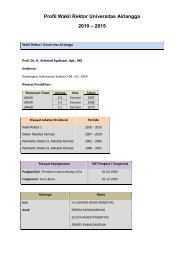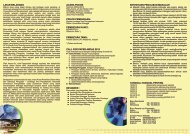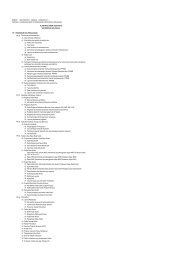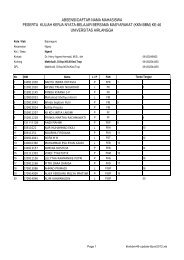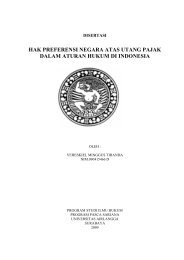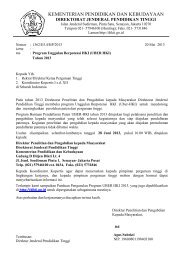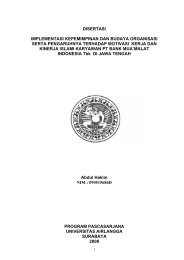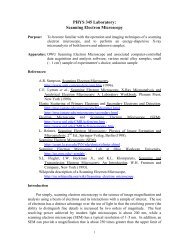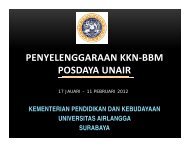View - UNAIR | E-Book Collection
View - UNAIR | E-Book Collection
View - UNAIR | E-Book Collection
You also want an ePaper? Increase the reach of your titles
YUMPU automatically turns print PDFs into web optimized ePapers that Google loves.
Fig. 8. Kayapo blockade ofCuiaba-Santarem highway,22-26 July 2006. A warriorguards a barricade across theCuiaba-Santarem highway. Thebanner across the barricadebears the message, ‘Why won’tyou listen to us? Kayapo,Panara, Terena, Kayabiand Apiaca Indians demandtheir rights!’. Note stalledtraffic behind the barrier. TheKayapo provisionally liftedthe blockade when federaland state governments agreedto send representatives tomeet with them and receivetheir demands that legalmeasures designed to limitthe environmental and socialimpact of development on localpopulations be enforced.MS (ManchetesSocioambientais) 2006.Website of the InstitutoSocio-Ambiental, São Paulo.http://www.socioambiental.org; consulted July-August2006.Scott, J. 1985. Weapons ofresistance: Everyday formsof peasant resistance. NewHaven: Yale UniversityPress.— 1990. Domination and thearts of resistance: Hiddentranscripts. New Haven: YaleUniversity Press.Switkes, G. (ed.) 2005.Tenotã-mõ: Alertas sobre asconsequencias dos projetoshidrelétricos no rio Xingú.São Paulo: InternationalRivers Network.Turner, T. 1991. Representing,resisting, rethinking:Historical transformationsof Kayapo cultureand anthropologicalconsciousness. In: Stocking,G. (ed.) Post-colonialsituations: The history ofanthropology, vol. 7, pp.285-313. Madison, WI:University of WisconsinPress.— 1992. Defiant images: TheKayapo appropriation ofvideo. Anthropology Today8(6): 5-15.— 2003. Class projects,social consciousness,and the contradictions of‘globalization’. In Friedman,J. (ed.) Violence, the stateand globalization, pp. 35-66.New York: Altamira.— 2004. Anthropologicalactivism, indigenous peoplesand globalization. In:Nagengast, C. and Velez-Ibañez, C. (eds) Humanrights, power and difference:The scholar as activist,pp. 193-207.OklahomaCity: Society for AppliedAnthropology.Txukarramãe, M. 2006.‘Declaração da reunião dopovo Mebengokre Kayapo,Piaraçu, MT 28 Março-1 Avril 2006’ (Englishtranslation by T. Turner:‘Declaration of the meetingof the Mebengokre Kayapoat Piaraçu, Mato Grosso,March 28-April 1, 2006’).managed to present themselves as defenders of Brazilianlaw against Brazilian national and state governments withrogue developmentalist agendas that flagrantly violatestanding Brazilian legislation for the protection of indigenouspeoples’ territorial and human rights and environmentalvalues. In the process they have managed to gain thesupport of significant sectors of Brazilian political opinionand state apparatuses, including important elements of thelegal and judicial establishments, some government ministriesand elected members of Congress, including agentsof FUNAI itself.Kayapo leaders like Megaron have even been able togain appointments to strategic regional posts within theadministrative structure of FUNAI. In contrast to Scott’sscenario of ‘weapons of the weak’ to which we alludedat the beginning of this article, in short, the state doesnot confront the Kayapo as a monolithic entity with aneffective monopoly of political- economic and ideologicalhegemony. On the contrary, it is a heterogeneous collectionof actors and agencies, many with programmes oftheir own that are to varying degrees opposed to the developmentalistpolicies of the head of state. The Kayapo, aswe have seen, have been able to co-opt some of these discordantstate powers as ‘weapons’ in their own struggleswith federal and state governments.In a similar way, the Kayapo have managed to attractsignificant support from new domestic and internationalsocial movements (NSMs) and non-governmental organizations(NGOs). The growth of these essentially middleclassmovements committed to universal values andcauses such as human rights and environmentalism, oftenopposed to the interests and projects of globalized capital,has been a prominent feature of the social dynamics ofglobalization.The Kayapo, with some help from anthropologists andNGO representatives, quickly understood that their strugglesfor territorial and cultural rights and protection of theirenvironment converged in important, if not all, respectswith the causes being fostered by these movements. Acrucial part of that understanding was the importance ofovertly representing themselves as a group of distinctiveidentity capable of acting independently in defence of theircultures, lands and environment. In contrast to the covertforms of resistance or ‘hidden transcripts’ that James Scotthas suggested are the essential ‘weapons of the weak’, inother words, the Kayapo have developed a flamboyantly‘open transcript’, consisting of their own overt representationsand public acts of opposition to Brazilian statepolicies and powers (cf. Scott 1985, 1990; Turner 1991,1992).An important aspect of this ‘open transcript’ has beenthe Kayapo’s development of new forms and techniquesof representation, including the creative use of new mediasuch as video but also adaptations of their traditional culturalforms such as ritual choreography and self-decoration,employed in staging demonstrations and politicalconfrontations. These innovative forms of representation,and the support from national and international civil societythey have helped to win, in sum, have also been important‘weapons’ in the Kayapo struggle (Fajans-Turner 2004,Turner 1991, Keck and Sikkink 1998).The Kayapo have been able to co-opt and employ thepowers derived from these extraneous sources by drawingupon the political qualities and cultural resources developedin their traditional system. These qualities wereepitomized by their creation of the inter-ethnic allianceof ‘peoples of the Xingú’ at the Piaraçu meeting of 2003(Fajans-Turner and Turner 2005) and the new level of rituallygrounded political unity for their own people at the2006 Piaraçu meeting described at the beginning of thisarticle. If the peoples and ecosystem of the Amazon are tobe saved from the ravages of the Brazilian regime’s developmentalistpolicies, they will owe much to the Kayapo’sability to exploit the conflicting currents of global civilsociety and discordant elements of modern state regimesas sources of new powers of resistance and adaptation. •TERENCE URNER10 ANTHROPOLOGY TODAY Vol 22 No 5, October 2006



